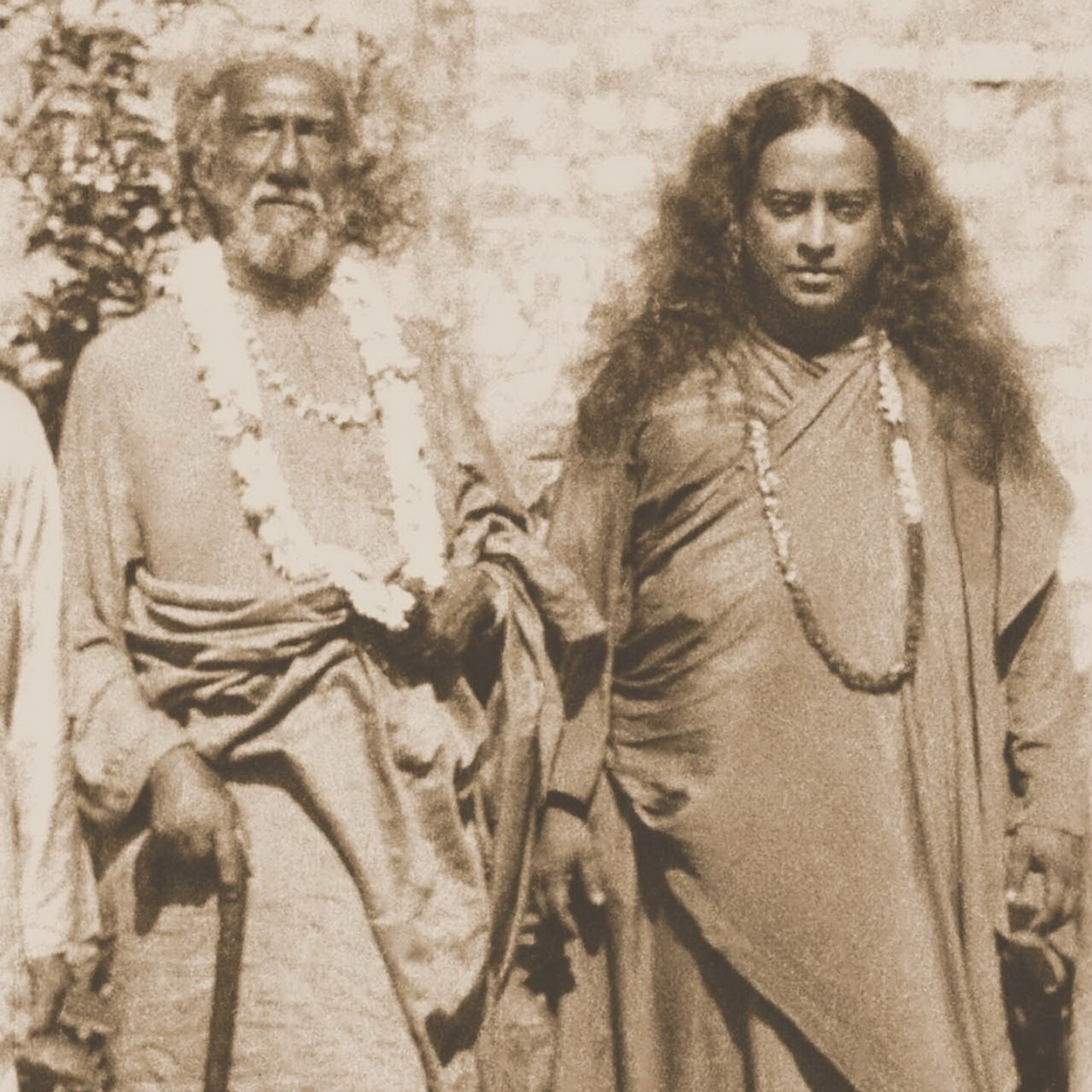Spiritual Lineage
The teachings of Self-Realization Fellowship/Yogoda Satsanga Society of India are founded upon the original Christianity of Jesus Christ and the original Yoga of Bhagavan Krishna. The spiritual lineage of SRF/YSS consists of these two great avatars and a line of exalted masters of contemporary times: Mahavatar Babaji, Lahiri Mahasaya, Swami Sri Yukteswar, and Paramahansa Yogananda (last in the line of SRF/YSS Gurus).
Each of these Great Ones played a role in Self-Realization Fellowship's mission of bringing to the modern world the spiritual science of Kriya Yoga.
The passing of a guru's spiritual mantle to a disciple designated to carry on the lineage to which that guru belongs is termed guru-parampara. Thus, Paramahansa Yogananda's direct lineage of gurus is Mahavatar Babaji, Lahiri Mahasaya, and Swami Sri Yukteswar.
All members of Self-Realization Fellowship (monastics as well as lay members) who have taken the sacred initiation in Kriya Yoga are disciples of Paramahansa Yogananda. He is given respect and devotion as their personal guru, and his lineage of Gurus is likewise venerated by SRF disciples.
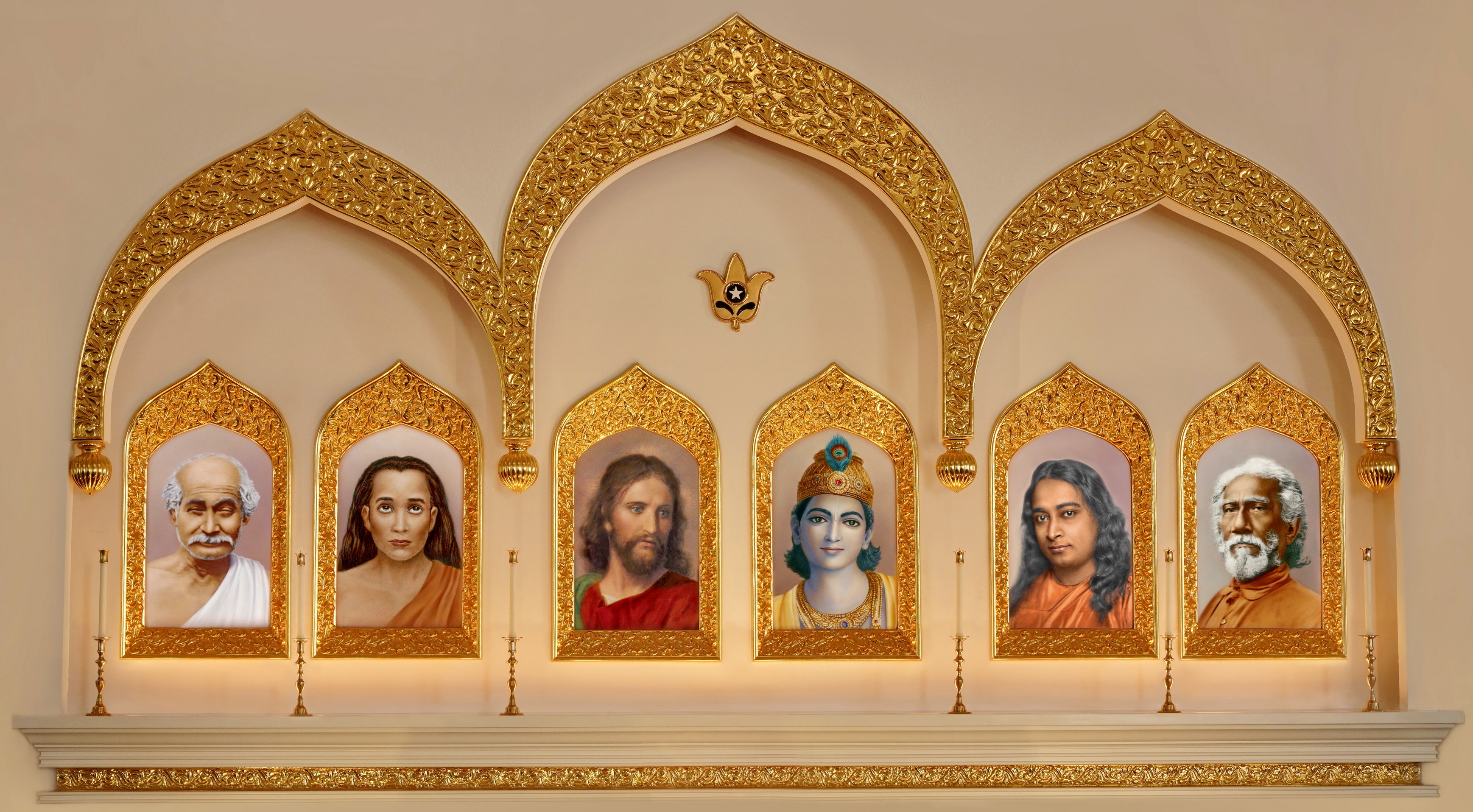
One of the essential goals of Paramahansa Yogananda’s mission was “to reveal the complete harmony and basic oneness of original Christianity as taught by Jesus Christ and original Yoga as taught by Bhagavan Krishna; and to show that these principles of truth are the common scientific foundation of all true religions.”
To the public at large, Jesus propounded a simple philosophy of faith, love, and forgiveness. He spoke often in parables, pregnant with timeless morals. But to his close disciples he taught deeper truths, truths that have their correspondence in the deepest metaphysical concepts of the more ancient yoga philosophy.
When his disciples questioned Jesus, “Why speakest thou unto them in parables?” he answered, “Because it is given unto you to know the mysteries of the kingdom of heaven, but them it is not given....Therefore speak I to them in parables: because they seeing see not; and hearing they hear not, neither do they understand” (Matthew 13:10, 11, 13).
The full understanding of Jesus’ original teachings — including the fact that he bestowed on his disciples the esoteric techniques of yoga meditation — is revealed in Paramahansa Yogananda’s in-depth commentary on the Gospels: The Second Coming of Christ: The Resurrection of the Christ Within You. In his Introduction to that work, Yogananda wrote:
“Jesus Christ is very much alive and active today. In Spirit and occasionally taking on a flesh-and-blood form, he is working unseen by the masses for the regeneration of the world. With his all-embracing love, Jesus is not content merely to enjoy his blissful consciousness in Heaven. He is deeply concerned for mankind and wishes to give his followers the means to attain the divine freedom of entry into God’s Infinite Kingdom. He is disappointed because many are the churches and temples founded in his name, often prosperous and powerful, but where is the communion that he stressed — actual contact with God? Jesus wants temples to be established in human souls, first and foremost; then established outwardly in physical places of worship. Instead, there are countless huge edifices with vast congregations being indoctrinated in churchianity, but few souls who are really in touch with Christ through deep prayer and meditation.
“To reestablish God in the temples of souls through revival of the original teachings of God-communion as propounded by Christ and Krishna is why I was sent to the West by Mahavatar Babaji....
“Babaji is ever in communion with Christ; together they send out vibrations of redemption and have planned the spiritual technique of salvation for this age.”
Bhagavan Krishna lived many centuries before Christ. Revered throughout India as an avatar (incarnation of God), the historical facts of Krishna’s life are interwoven with a maze of legend and mythology.
The sublime teachings of Lord Krishna are enshrined in the Bhagavad Gita. In his highly acclaimed two-volume commentary on the Gita, Paramahansa Yogananda has written:
“The Bhagavad Gita is the most beloved scripture of India, a scripture of scriptures. It is the Hindu’s Holy Testament, or Bible, the one book that all masters depend upon as a supreme source of scriptural authority....
“So comprehensive as a spiritual guide is the Gita that it is declared to be the essence of the ponderous four Vedas, 108 Upanishads, and the six systems of Hindu philosophy....The entire knowledge of the cosmos is packed into the Gita. Supremely profound, yet couched in revelatory language of solacing beauty and simplicity, the Gita has been understood and applied on all levels of human endeavor and spiritual striving — sheltering a vast spectrum of human beings with their disparate natures and needs. Wherever one is on the way back to God, the Gita will shed its light on that segment of the journey....
“Krishna is the divine exemplar of yoga in the East; Christ was chosen by God as the exemplar of God-union for the West....The Kriya Yoga technique, taught by Krishna to Arjuna and referred to in Gita chapters IV:29 and V:27–28, is the supreme spiritual science of yoga meditation. Secreted during the materialistic ages, this indestructible yoga was revived for modern man by Mahavatar Babaji and taught by the Gurus of Self-Realization Fellowship/Yogoda Satsanga Society of India.”
There are no historical records relating to the birth and life of Mahavatar Babaji. Paramahansa Yogananda has written in Autobiography of a Yogi that the deathless avatar has resided for untold years in the remote Himalayan regions of India, revealing himself only rarely to a blessed few.
It is Mahavatar Babaji who revived in this age the lost scientific meditation technique of Kriya Yoga. In bestowing Kriya initiation on his disciple Lahiri Mahasaya, Babaji said, “The Kriya Yoga that I am giving to the world through you in this nineteenth century is a revival of the same science that Krishna gave millenniums ago to Arjuna; and that was later known to Patanjali and Christ, and to St. John, St. Paul, and other disciples.”
Shortly before Paramahansa Yogananda left for America in 1920, Mahavatar Babaji came to Paramahansaji’s father’s home in Kolkata, where the young monk sat deeply praying for divine assurance regarding the mission he was about to undertake. Babaji said to him: “Follow the behest of your guru and go to America. Fear not; you shall be protected. You are the one I have chosen to spread the message of Kriya Yoga in the West.”
Lahiri Mahasaya was born on September 30, 1828, in the village of Ghurni in Bengal, India. At the age of thirty-three, while walking one day in the Himalayan foothills near Ranikhet, he met his guru, Mahavatar Babaji. It was a divine reunion of two who had been together in many lives past; at an awakening touch of blessing, Lahiri Mahasaya became engulfed in a spiritual aura of divine realization that was never to leave him.
Mahavatar Babaji initiated him in the science of Kriya Yoga and instructed him to bestow the sacred technique on all sincere seekers. Lahiri Mahasaya returned to his home in Banaras to fulfill this mission. As the first to teach the lost ancient Kriya science in contemporary times, he is renowned as a seminal figure in the renaissance of yoga that began in modern India in the latter part of the nineteenth century and continues to this day.
Paramahansa Yogananda wrote in Autobiography of a Yogi: “As the fragrance of flowers cannot be suppressed, so Lahiri Mahasaya, quietly living as an ideal householder, could not hide his innate glory. Devotee-bees from every part of India began to seek the divine nectar of the liberated master....The harmoniously balanced life of the great householder-guru became the inspiration of thousands of men and women.”
As Lahiri Mahasaya exemplified the highest ideals of Yoga, union of the little self with God, he is reverenced as a Yogavatar, or incarnation of Yoga.
Paramahansa Yogananda’s parents were disciples of Lahiri Mahasaya, and when he was but a babe in arms his mother carried him to the home of her guru. Blessing the infant, Lahiri Mahasaya said, “Little mother, thy son will be a yogi. As a spiritual engine, he will carry many souls to God’s kingdom.”
Lahiri Mahasaya established no organization during his lifetime, but made this prediction: “About fifty years after my passing, an account of my life will be written because of a deep interest in Yoga that will arise in the West. The message of Yoga will encircle the globe. It will aid in establishing the brotherhood of man: a unity based on humanity’s direct perception of the one Father.”
Lahiri Mahasaya entered mahasamadhi in Banaras, September 26, 1895. Fifty years later, in America, his prediction was fulfilled when an increasing interest in yoga in the West inspired Paramahansa Yogananda to write Autobiography of a Yogi, which contains a beautiful account of Lahiri Mahasaya’s life.
Swami Sri Yukteswar was born on May 10, 1855, at Serampore in Bengal, India. Sri Yukteswar was a disciple of Lahiri Mahasaya and attained the spiritual stature of a Jnanavatar, or incarnation of wisdom.
Sri Yukteswar recognized that a synthesis of the spiritual heritage of the East with the science and technology of the West would do much to alleviate the material, psychological, and spiritual suffering of the modern world. These ideas were crystallized by his remarkable encounter with Mahavatar Babaji, the guru of Lahiri Mahasaya, in 1894.
“At my request, Swamiji,” Babaji said to him, “will you not write a short book on the underlying harmony between Christian and Hindu scriptures? Their basic unity is now obscured by men’s sectarian differences. Show by parallel references that the inspired sons of God have spoken the same truths.”
Sri Yukteswar recounted: “In the quiet of night I busied myself over a comparison of the Bible and the scriptures of Sanatan Dharma. Quoting the words of the blessed Lord Jesus, I showed that his teachings are in essence one with the revelations of the Vedas. Through the grace of my paramguru, my book, The Holy Science, was finished in a short time.”
It was to Swami Sri Yukteswar that Paramahansa Yogananda came as a youth. The great guru told his young disciple that, during their meeting in 1894, Mahavatar Babaji had informed him: “You, Swamiji, have a part to play in the coming harmonious exchange between Orient and Occident. Some years hence I shall send you a disciple whom you can train for yoga dissemination in the West. The vibrations there of many spiritually seeking souls come floodlike to me. I perceive potential saints in America and Europe, waiting to be awakened.”
After relating this, Sri Yukteswar told Yogananda, “My son, you are the disciple that, years ago, Babaji promised to send me.”
Under Sri Yukteswar’s spiritual training and discipline, Sri Yogananda was prepared to begin his worldwide mission in the West. Sri Yukteswar named Paramahansa Yogananda sole heir to his spiritual mantle and ashram properties.
Swami Sri Yukteswar entered mahasamadhi on March 9, 1936, during Paramahansaji’s visit to India after fifteen years in America.
As described above, Paramahansa Yogananda was personally blessed by Mahavatar Babaji, Lahiri Mahasaya, and Swami Sri Yukteswar — all three of the paramgurus in his spiritual lineage — to carry out the mission of disseminating Kriya Yoga worldwide.
In Autobiography of a Yogi he wrote: “The founding in the West of a Self-Realization Fellowship organization, a ‘hive for the spiritual honey,’ was a duty enjoined on me by Sri Yukteswar and Mahavatar Babaji.”
Organizational Leadership Since Yogananda’s Passing
Before his passing, Paramahansa Yogananda stated that it was God's wish that he be the last in the SRF line of Gurus. No succeeding disciple or leader in his society will ever assume the title of guru. (This divine ordinance is not unique in religious history. After the passing of Guru Nanak, the great saint who founded the Sikh religion in India, there was the usual succession of gurus. The tenth guru in the line announced he was to be the last of that line of gurus, and henceforth the teachings were to be considered the guru.)
Paramahansaji gave the assurance that, after his passing, he would continue to work through the society he founded, Self-Realization Fellowship/Yogoda Satsanga Society of India. He stated, “When I am gone the teachings will be the guru….Through the teachings you will be in tune with me and the great Gurus who sent me.”
When questioned about the succession of SRF/YSS leadership, Paramahansaji answered, “There will always be at the head of this organization men and women of realization. They are already known to God and the Gurus. They shall serve as my spiritual successor and representative in all spiritual and organizational matters.”
Successors to Paramahansa Yogananda
Rajarsi Janakananda
From its founding in 1920 until shortly before Paramahansa Yogananda’s mahasamadhi in 1952, all of Self-Realization Fellowship’s activities and organizational matters were personally directed by Yogananda himself. Thereafter, the leadership of his work passed to Rajarsi Janakananda, a close disciple of Paramahansaji’s chosen by him to serve as president of SRF and who succeeded him upon his passing in March 1952.
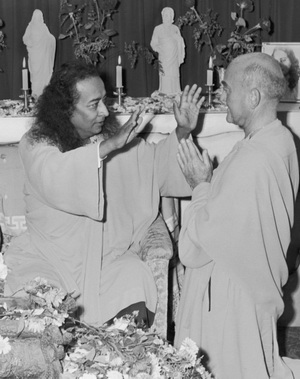
Born James J. Lynn on May 5, 1892, in Archibald, Louisiana, Rajarsi Janakananda met Paramahansa Yogananda during the guru's lecture series in Kansas City in 1932.
Because of his rapid advancement in Kriya Yoga, Paramahansaji lovingly referred to him as “Saint Lynn.” In 1951 Yogananda bestowed on him the monastic title of Rajarsi Janakananda (after the spiritually illustrious King Janaka of ancient India) and turned over to him the responsibility of guiding the SRF/YSS work.
The exemplary life of Rajarsi Janakananda, a great Western yogi, came to an end on February 20, 1955.
Sri Daya Mata
Sri Daya Mata succeeded Rajarsi Janakananda as the third president and spiritual head of Self-Realization Fellowship/Yogoda Satsanga Society of India in 1955.
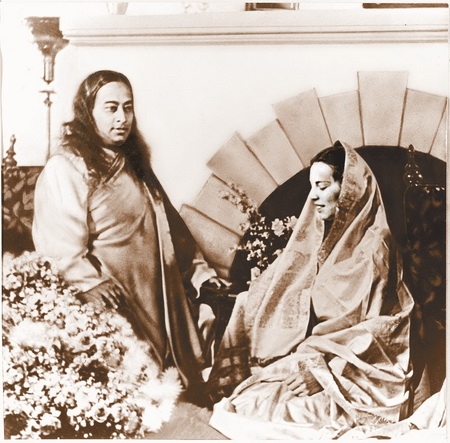
Born in Salt Lake City on January 31, 1914 as Faye Wright, she met Paramahansa Yogananda when he came to give lectures and classes there in 1931. Shortly thereafter, she entered his ashram as a nun.
For more than twenty years, Sri Daya Mata was part of the small circle of his closest disciples, who were with him almost constantly. As the years passed, he assigned more and more responsibility to her, personally appointing her as an officer on the SRF Board of Directors in the 1930s when she was still a young woman. In the closing period of his life, Yogananda placed her in charge of the SRF International Headquarters and began to speak openly to the disciples of the worldwide role she was destined to play. Shortly before his passing, he told her: “Now my work is finished; your work begins.”
Paramahansaji's choice of Sri Daya Mata as the future leader of his worldwide society was confirmed by Mahavatar Babaji in an encounter Daya Mata had with the Mahavatar during a pilgrimage in India in 1962.
Sri Daya Mata passed away on November 30, 2010, after more than 55 years as SRF/YSS president.
Sri Mrinalini Mata
Sri Mrinalini Mata succeeded Sri Daya Mata as president and spiritual head of Self-Realization Fellowship/Yogoda Satsanga Society of India on January 7, 2011, and served in these roles until her passing on August 3, 2017. She too had been personally chosen and trained by Yogananda to help guide the work after his passing, and played many important leadership roles during her seven decades as an SRF monastic disciple.
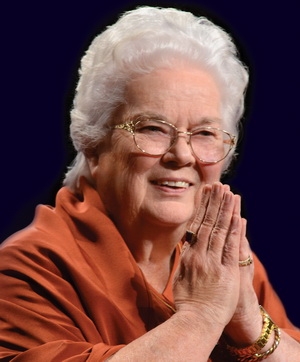
Born in 1931 in Wichita, Kansas, Mrinalini Mata met Paramahansa Yogananda in December 1945 at the age of fourteen and shortly afterwards entered the Guru’s ashram in Encinitas, California, to dedicate herself to a life of service as a nun.
From the very beginning of Mrinalini Mata’s life in the ashram, Paramahansaji spoke to her and the other disciples about the role he envisioned for her—especially her future responsibility as editor of his Self-Realization Fellowship Lessons, writings, and talks. “She was destined for this work,” he said in a handwritten letter to Rajarsi Janakananda in 1950. “God showed it to me when I first saw her spirit.”
In addition to serving for decades as editor-in-chief of SRF/YSS publications, Sri Mrinalini Mata also served as SRF vice president for forty-five years, closely assisting Sri Daya Mata in the overall guidance of the SRF/YSS monastic order and overseeing the numerous activities and services of the society worldwide.
Brother Chidananda
On August 30, 2017, Brother Chidananda succeeded Sri Mrinalini Mata as the fifth president and spiritual head of SRF/YSS. He has been a monk of Self-Realization Fellowship for more than forty years.
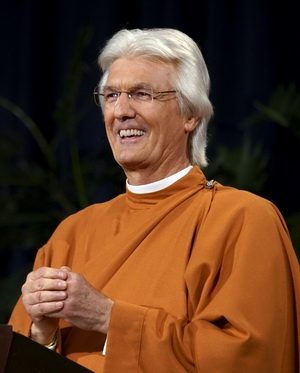
Almost from the start of his monastic life, Brother Chidananda worked closely with Sri Mrinalini Mata assisting her in the editing and publishing of the works of Paramahansa Yogananda and other SRF publications. He was appointed a member of the SRF and YSS Boards of Directors by Sri Daya Mata in 2009, and has also served for many years as a member of the management committee that oversees SRF’s myriad activities and operations under the guidance of the president. As president, Brother Chidananda is assisted by a Board of Directors, which includes other monastics who have been trained by direct disciples of Paramahansaji.
Direct Disciples of Yogananda
Dozens of direct disciples who had benefited from personal association with Yogananda lived out their lives in SRF ashrams in the decades following his passing, loyally serving his organization and supporting the leadership he had appointed.
Current Board of Directors, Monastic Order, and Lay Membership
All of the members of the Board of Directors are members of our monastic order who have taken final, lifelong vows of renunciation. Serving without salary, they and the other monks and nuns in SRF ashrams have devoted their lives fully to the mission begun by Paramahansa Yogananda.
Under the direction of the president and Board of Directors, monks and nuns of the SRF Order serve in many capacities in the society’s ashram centers; travel to cities around the world to conduct lectures and classes and to lead retreats; and provide spiritual counsel and guidance—by phone, letter, and in person—to students of the Self-Realization Fellowship teachings.
Many dedicated SRF lay members also serve Paramahansa Yogananda’s worldwide work in indispensable ways—working with the monastics at the International Headquarters and other SRF ashram centers, and carrying many responsibilities in the temples and meditation centers around the world.


